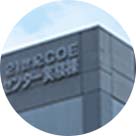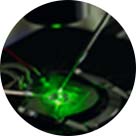Interface science is a field of study that deals points, lines, surfaces, and volumes (spaces), and uses geometry such as dimensions, sizes, shapes, boundaries, front and back, and connectivity as elements, and comprehensively systematizes these phenomena. In particular, interface science deals mainly with“ particles” (all three dimensions are colloidal dimensions),“ lines (wires)” (two dimensions are colloidal
dimensions), and“ membranes” (only one dimension is colloidal dimension), where at least one of the three dimensions is a colloidal dimension (1 nm – 1 μm), making it a unique academic field that deals with a wide range of research topics. This division views the interface as a “spatio-temporal functional expression field that integrates different fields”. Starting from the verification and demonstration of
conventional interface theories, we aim to create new physical properties, functions, and theories, and ultimately develop unprecedented novel functional materials. Specific research targets are diverse, include soft (mainly organic) materials, hard (mainly inorganic) materials, nanomaterials, and biomaterials.
We promote projects from both basic and applied perspectives.
Tokyo University of Science has traditionally had laboratories specializing in “interface science” on each campus. The Division of Colloid and Interface Science was established in 1981 by the researchers specializing in this fields, and has been active as a cross-campus and cross-departmental research center, and its activities are widely recognized in Japan and around the world. The first Director, Professor Kenjiro Meguro (Faculty of Science Division I) was succeeded by Professor Tamotsu Kondo (Faculty of Pharmaceutical Sciences), Professor Minoru Ueno (Faculty of Science Division I), Professor Kijiro Konno (Faculty of Engineering), Hiroyuki Ohshima (Faculty of Pharmaceutical Sciences), Professor Takeshi Kawai (Faculty of Engineering). Since 2018, Professor Hideki Sakai (Faculty of Science and Technology) has led the division as the director. In the meantime, the division had been shifted to the Center for Colloid and Interface Science during FY 2008-2012, because a project application was accepted as the MEXT Program for the Development of Strategic Research Bases.
We would like to introduce our recent activities. In FY 2013-2017 (Director: Prof. Kawai), we divided the research subjects of interface science into two major areas, soft and hard interfaces, and worked to deepen our understanding of dynamic interface phenomena. The soft and hard interfaces here are different from the general definition that distinguishes between then by the substances that make up the interface. A“ soft interface” is a dynamic interface in which the molecules (atoms) forming the interface are constantly replaced during normal observation time, such as micelles (molecular assemblies) of surfactants. On the other hand, a “hard interface” is a rigid interface in which there is (almost) no
replacement of surface constituent molecules (atoms), such as metal nanoparticles. The division members were divided into groups dealing with“ soft interfaces” and “hard interfaces”, and each interface was further classified into one-dimensional, two-dimensional, and three-dimensional interfaces. We
promoted accurate understanding of the phenomena at the interface and “manufacturing” research using interface science (Fig. 1). The researchers who conduct research on the theme of interface science from the aspects of chemistry, physics, bioscience, theoretical chemistry, and other fields have collaborated to achieve synergistic results, especially with regard to “stimulusresponsive interfaces that respond to external stimuli such as light, temperature, and electricity”.
In FY 2018-2022 (Director: Prof. Sakai), the researchers who specialize in physics, mechanics, pharmacology, theoretical science, and measurement science joined the membership, which was previously mainly consisted of chemists. With the support of advanced measurement science and theoretical science, we have set a new goal of conducting “accurate understanding of the interface dynamics/reaction mechanism at the interface” regarding “manufacturing using interface science”. Especially in the fields of “advanced interface measurements”, “stimulus-responsive materials”, and “biofunctional interfaces”, we were able to achieve many results, including collaborations among members with different specialties. We also strengthened our ties with industry by actively holding seminars by corporate researchers. In addition, we contributed to public outreach, such as by cooperating with open colleges.
From FY 2023, together with the new members, we will promote research development with a focus on“ dynamics at interfaces” as the most important issue, based on the achievements accumulated by the division so far. For example, in understanding the dynamic functions of materials formed by molecular
assemblies, we will understand the linkage of“ dynamics of molecules” →“ dynamics of molecular assemblies” →“ dynamics of functions of molecular assemblies” and link this knowledge to the“ creation of functional materials” based on new ideas. In addition, we will promote activities aimed at turning our university and this division into an international research base in interface science research, through
active dissemination of our results overseas, participation in international conferences, and collaboration with overseas universities.


Regarding the operation of the division, we have set “advanced interface measurements/theoretical analyses”, “stimuli-responsive interfaces”, and “biointerfaces” as priority themes, and promote research development with an awareness of collaboration between members while utilizing their specialties
(Fig. 2). In particular, we will promote further collaboration between experts in both materials fabrication and theory in order to understand and utilize dynamics at interfaces as described above. In addition, we will work on creating a system that feeds back the results obtained in one material system to other systems and utilizes them. We will develop the results of “only at TUS”, and integrate collaborations within the group, and in the future, we will open up new research areas by the entire division and lead to the acquisition of external research funds. We will also continue the cooperation with industry that we have cultivated so far, and continue activities such as cooperating with open colleges. As for international activities, we aim to effectively coordinate the efforts of individual members so far and develop the division into an international base. We will continue the activities such as research presentations in English by graduate students at the summer symposium. We also start activities to publish an English book on dynamics of interfaces.












